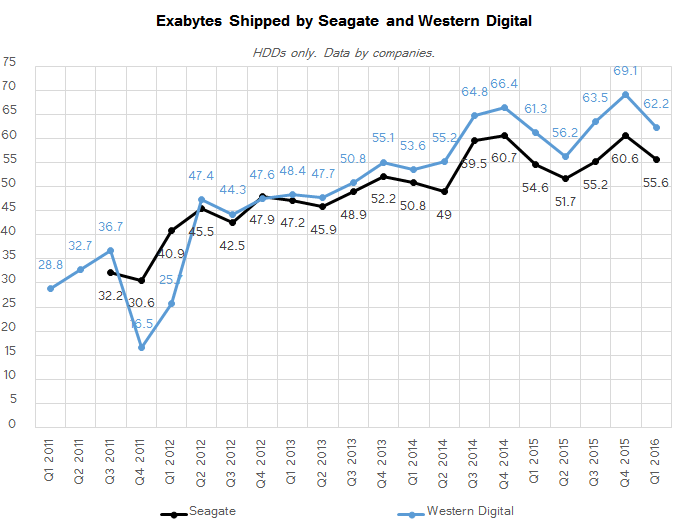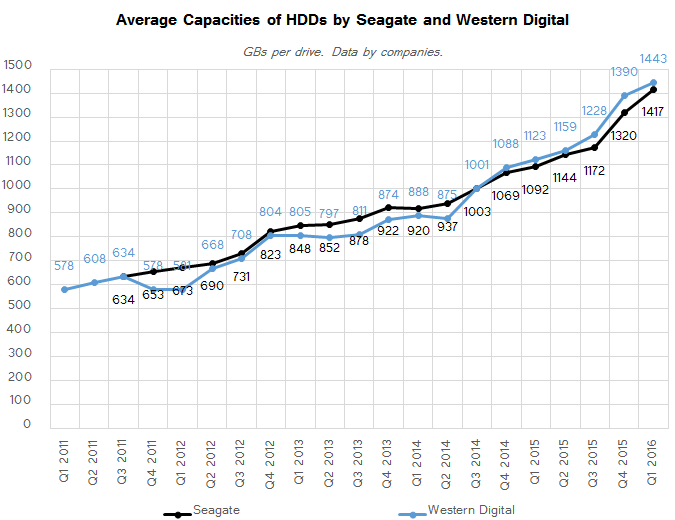Market Views: HDD Shipments Down 20% in Q1 2016, Hit Multi-Year Low
by Anton Shilov on May 12, 2016 8:00 AM ESTAverage HDD Capacities Continue to Increase
Despite the drop in HDD unit shipments, both sequentially and year-over-year, total capacities shipped by the two leading makers of hard drives increased in Q1. Seagate supplied 55.6 EB (Exabyte) of HDD storage last quarter, up from 54.6 EB in Q1 2015, but down from 60.6 EB in the previous quarter. The total capacity of Western Digital’s HDDs shipped in the first quarter of 2016 was approximately 62.2 EB, a moderate increase from 61.3 EB in Q1 2015.
When it comes to hard drives, one thing that has been growing quarter-over-quarter for a long time now is average HDD capacity, particularly in the enterprise segment, but not only there. In Q1 2016, an average drive could store around 1.4 TB of data, an increase of 28.5% (Western Digital) and 29.7% (Seagate) from the same quarter last year.
Average HDD Price Stays at $60 compared to Q1 2015
Despite the local price hikes by HDD makers, the industry can clearly produce more hard drives than it can consume, which is why prices of mass HDD models remain rather low. This will likely change in the future, when consumers shift to higher-capacity drives because of 4K UHD video or other reasons, but right now an average HDD from either Seagate of Western Digital costs approximately $60.
This will likely change after Seagate implements its plans to cut down its manufacturing capacities and supply-demand balance of the market will stabilize. However, it remains to be seen how significantly that is going to change going forward.













116 Comments
View All Comments
Sivar - Thursday, May 12, 2016 - link
That's well and good unless capacity and cost is important. Hard drives are still less than 1/5 the cost per gigabyte, and that's compared to TLC, which has a relatively limited write capability.JoeyJoJo123 - Thursday, May 12, 2016 - link
>which has a relatively limited write capabilityPlease. Educate yourself. Review the TechReport's SSD Torture Test (literally Google "Tech Report SSD Torture Test") and you'll see even TLC SSDs withstood over a PB of data write/reads over the course of their lifetime and far exceeded the manufacturer's claims of endurance.
SSDs have much more endurance than advertised, and even if you were stupid enough to waste limited read/write cycles by performing three daily complete defrags on your SSD (which doesn't increase read/write speeds, but really only wastes time during the defrag and wears out the NAND chips a bit) you'd still have a working SSD 10 years from now. The bigger question then would be if motherboards 10 years from now would even support that SATA 3 SSD.
The consumer has literally NOTHING to worry about for SSD endurance. These figures ONLY see any relevance in data centers where data that is cached on SSDs is constantly read from by servers which deliver relevant data to clients and constantly written to be the storage server itself to hold newly cached data. In this situation only, these drives would get hammered 24/7 and having an SSD with longer endurance is the difference between causing undue downtime for clients (costing you $$$).
Byte - Saturday, May 14, 2016 - link
The only thing you have to worry about is cold storage for SSDs. Dell found after 6 months of no power you start to see data loss and some even report of loss in a few days at hot temperatures.Wolfpup - Thursday, July 14, 2016 - link
Yowzers, that's terrifying... We really, REALLY need something better than SSDs. They're just fragile and tiny.tamalero - Tuesday, May 17, 2016 - link
Agree with you, even with that.. Why would you need that many writes? HDDs or SSDs used for movie/series.. are a "write once, leave untouched forever and only read" kind of archival style usage.Id say in these kind of jobs.. Spin hdds degrade way faster (thanks to movement) than SSDs.
Wolfpup - Thursday, July 14, 2016 - link
Not if the cells lose their charge... Mechanical drives a lot of times you've got some warning that they're dying, and they can sit there for years and still work fine.Gigaplex - Friday, May 13, 2016 - link
When you're archiving large files, NAND write endurance is the least of your worries.Lolimaster - Friday, May 13, 2016 - link
Maybe because the people with actual need for space won't ask a typical seller and they simply use internet to know about it.Wolfpup - Thursday, July 14, 2016 - link
I honestly have no idea how anyone could survive with a 250GB drive... My main system I got in 2012 has a Seagate 750GB 7200 RPM drive (the largest available at the time for notebooks) and a 500GB Crucial SSD (again, the largest available at the time). I'd need multiple times more to not have to worry about what programs/media/whatever I have installed on it.lilmoe - Thursday, May 12, 2016 - link
I'm actually surprised the drop was only 20%